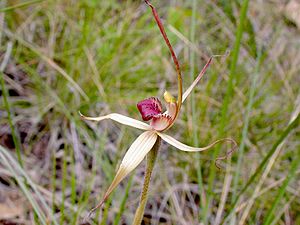Southern spider orchid facts for kids
Quick facts for kids Southern spider orchid |
|
|---|---|
 |
|
| Caladenia australis near Anglesea | |
| Scientific classification | |
| Genus: |
Caladenia
|
| Species: |
australis
|
| Synonyms | |
|
|
The Caladenia australis, commonly known as the southern spider orchid, is a special plant. It is part of the orchid family and grows only in Victoria, Australia. This type of plant is called endemic because it is found in just one area. It was also seen once on an island in Bass Strait in 1968. This orchid has one fuzzy leaf. It usually grows only one creamy-yellow flower with red stripes. The flower sits on a hairy stem.
Contents
What Does It Look Like?
The Southern Spider Orchid is a terrestrial plant. This means it grows in the ground. It is a perennial plant, so it lives for more than two years. It is also deciduous, meaning it loses its leaves at certain times. This plant is a herb with a hidden underground tuber. A tuber is like a small, round storage part. It has one hairy leaf that is about 5 to 17 centimeters (2 to 7 inches) long. The leaf is also about 4 to 11 millimeters (0.2 to 0.4 inches) wide.
The Flower's Features
Usually, there is only one flower on a thin, wiry stem. This stem is a bit hairy and grows about 12 to 30 centimeters (5 to 12 inches) tall. Each flower is about 50 to 60 millimeters (2 to 2.4 inches) wide. The top part of the flower, called the dorsal sepal, bends forward or hangs over the rest of the flower. All three sepals are 20 to 60 millimeters (0.8 to 2.4 inches) long. They are 2 to 4 millimeters (0.08 to 0.16 inches) wide. They get thinner at the end and have dark red, club-like glands.
The petals are similar in size and shape to the sepals. But they do not have the glandular ends. Both the petals and sepals spread out wide. Sometimes they droop a little at their ends. They are a creamy-yellow color. Often, they have cool red streaks.
The Labellum
The labellum is a special lip-like part of the orchid. It is shiny and yellowish with a maroon tip. It curves forward, and its tip rolls under at the end. The labellum is shaped like an egg. It is about 12 to 15 millimeters (0.5 to 0.6 inches) long. It is also about 3 millimeters (0.12 inches) wide. The edges of the labellum have many small teeth. These teeth can be up to 2 millimeters (0.08 inches) long. There are also 4 to 6 rows of dark red bumps called calli along the middle of the labellum. These calli get smaller towards the front.
When Does It Bloom?
This orchid flowers between September and November. Its flowering is much better if there were fires the summer before.
How It Got Its Name
Taxonomy and Naming
The Southern Spider Orchid was first officially described in 1991. This was done by a scientist named Geoffrey Carr. His description was published in a paper called Indigenous Flora and Fauna Association Miscellaneous Paper 1. The first example of this plant, called the type specimen, was found on Wilsons Promontory. The second part of its scientific name, australis, is a Latin word. It means "southern," which makes sense for a plant found in southern Australia!
Where It Lives
Distribution and Habitat
The Caladenia australis mostly grows in areas near the coast of Victoria. Even though it is found in many places, it is not very common. It likes to grow in heathlands and woodlands. It usually prefers sandy soil. There is only one record of it being found outside Victoria. That was on the southern part of Flinders Island in 1968.
Protecting the Orchid
Conservation Status
Scientists do not have enough information to fully assess how safe the Southern Spider Orchid is in Victoria. However, in Tasmania, it is listed as "Endangered." This means it is at a high risk of disappearing. This listing is under the Tasmanian "Threatened Species Protection Act 1995". Protecting these unique plants helps keep our natural world healthy.

